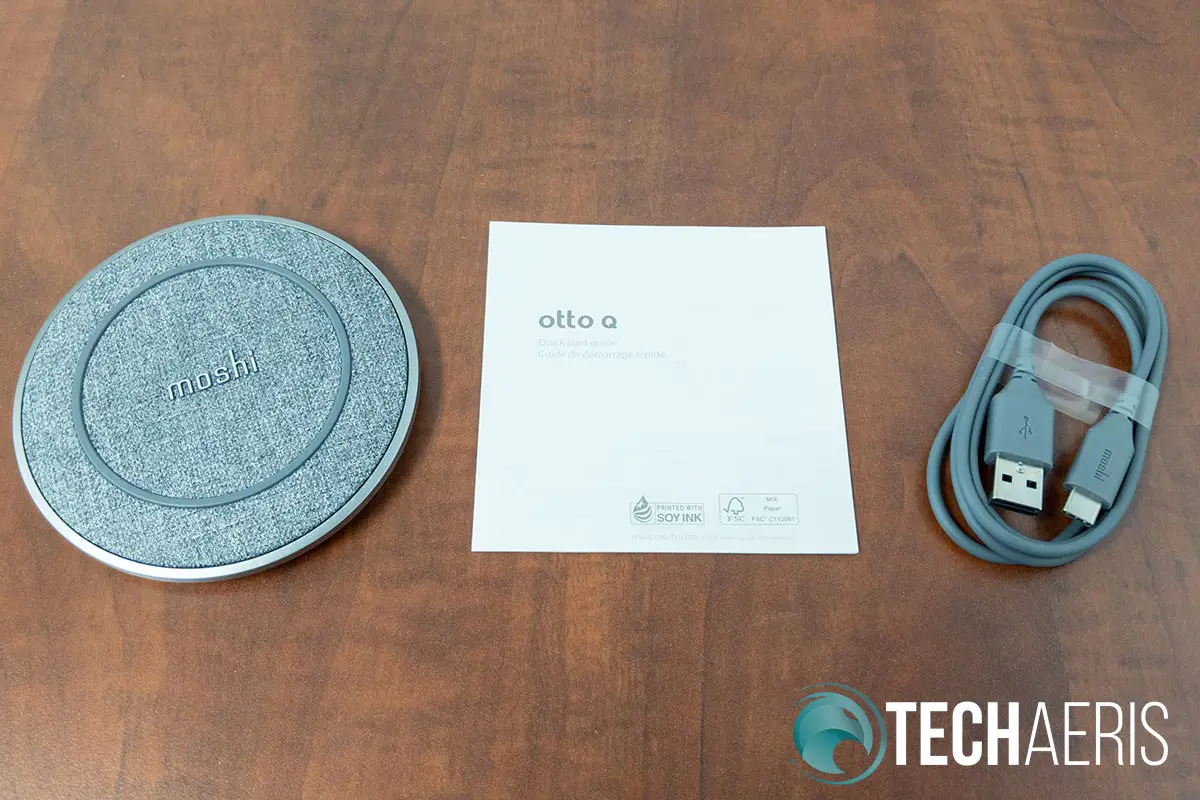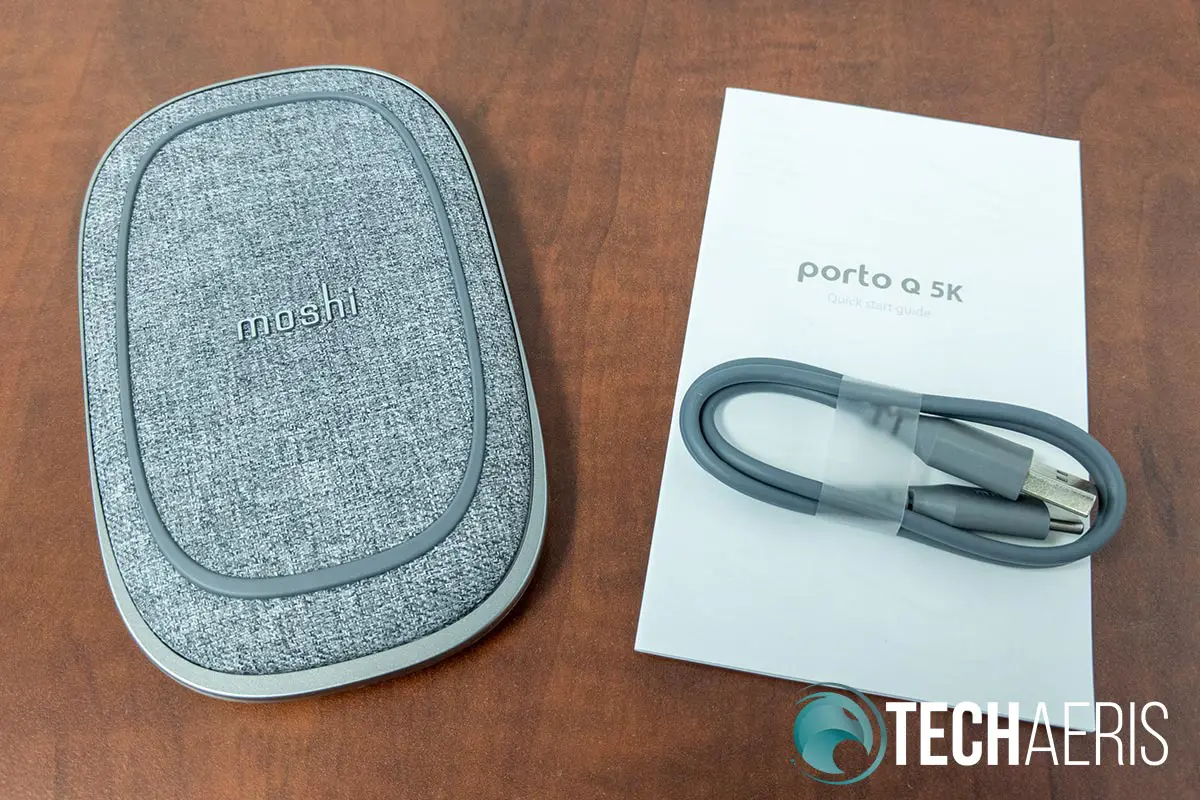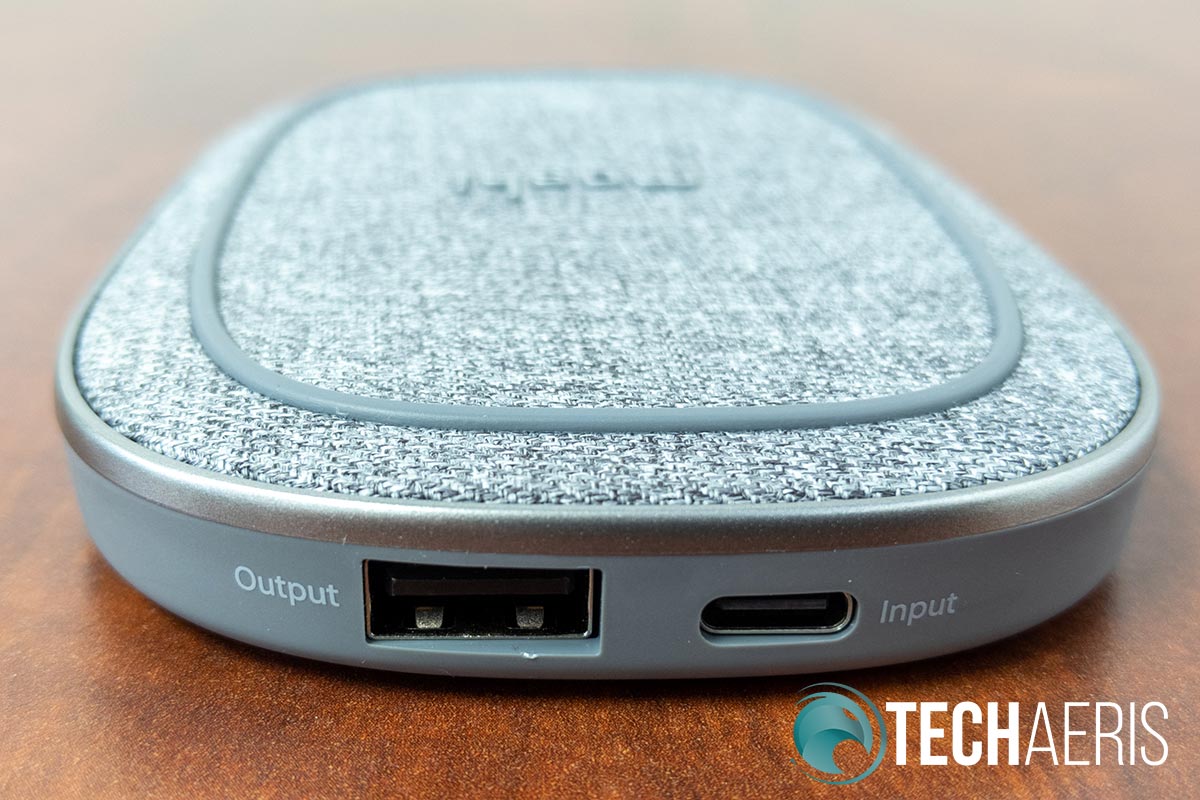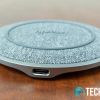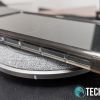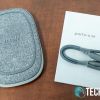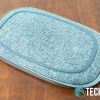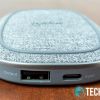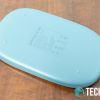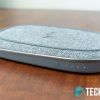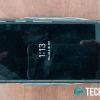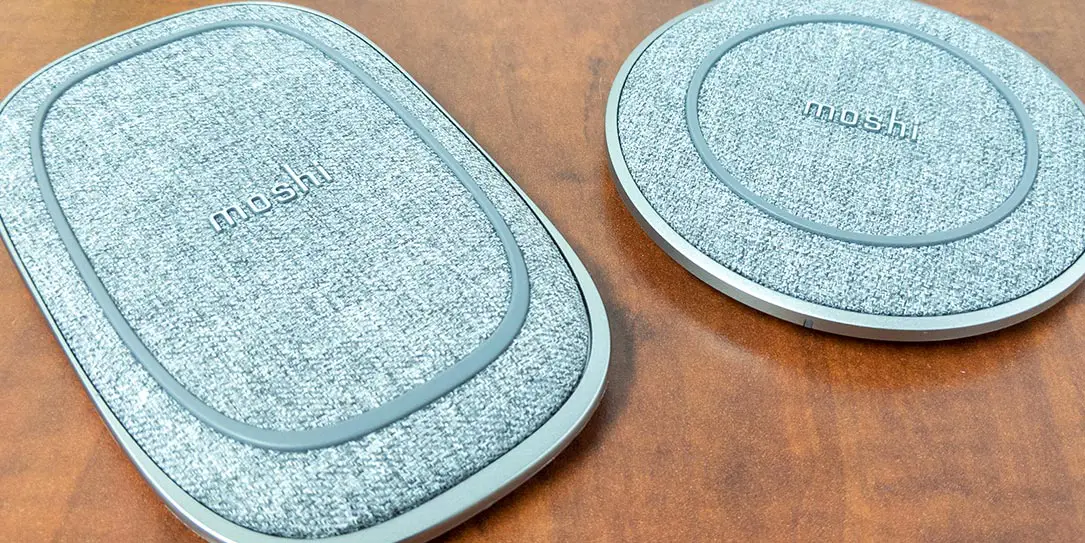Moshi released their latest collection of charging pads back in May: the Moshi Q Wireless Charging Collection. Consisting of the Moshi Otto Q, Porto Q, and Symbus Q, our Moshi Q Wireless Charging Collection review takes a look at the first two on the list with the Symbus Q reviewed separately. Read on to see how these stylish wireless charging pads perform!
Specifications
Moshi Otto Q
The Moshi Otto Q Wireless Charging Pad has the following features and specifications:
- Advanced Q-coil™ module for fast wireless charging
- Charges through cases up to 5 mm thick
- Supports fast-charging up to 10 W
- Non-slip surface ring and base for convenient one-hand usage
- LED charging indicator
- USB-C connector
- FOD (Foreign Object Detection) for added safety
- Includes a 3-foot USB-C to USB-A cable (1 m)
- Dimensions: 4.02″ x 4.02″ x 0.51″ (10.2 x 10.2 x 1.3 cm)
- Weight: 4.83 oz (137 g)
What’s in the box
- Otto Q
- 3-foot USB-C to USB-A cable
- Quick Start Guide
Moshi Porto Q 5K
The Moshi Porto Q Portable Battery with Wireless Charging has the following features and specifications:
- Portable battery with built-in Qi wireless charger
- Charges through cases up to 5 mm thick
- Non-slip surface ring and base for convenient one-hand usage
- FOD (Foreign Object Detection) for added safety
- Battery capacity: 5,000 mAh
- Includes a 1.5-foot USB-C to USB-A cable (50 cm)
- DC output
- USB-A: 5V/ 2.4A
- Wireless: 5W
- DC input
- USB-C: 5V/3A
- Dimensions: 5.24″ x 3.27″ x 0.57″ (13.3 x 8.3 x 1.45 cm)
- Weight: 5.5 oz (156 g)
What’s in the box
- Porto Q 5K
- 1.5-foot USB-C to USB-A cable
- Quick Start Guide
Design
Both the Moshi Otto Q and Porto Q 5K feature similar designs. The Otto Q is circular in shape while the Porto Q 5K is rectangular with rounded edges. A trademark of the Q Wireless Charging Collection, the top surface of both chargers is finished in a Nordic Gray fabric. A silicone strip sits on top of the fabric roughly half-an-inch inset from the outer edge of each charger. The Moshi logo is also raised in the center of each charger.
The outer edge is a silver plastic strip which looks like metal. In the case of the Otto Q, this silver wraps down and extends under the pad to the rubber circular base. The silver strip on the Porto Q, on the other hand, wraps around the edge slightly and meets up with the main grey plastic housing which makes up the base of the unit. Where the Otto Q has a circular rubber base, the Porto Q 5K just has four tiny plastic bumps to raise it slightly above whatever surface you’re setting it on.
Both devices have a “smart” LED on the front edge. When your device is wirelessly charging, this smart LED will pulse to indicate it’s dissipating a charge.
The Otto Q has a single USB-C port at the back while the Porto Q5K has a USB-C input and a USB-A output port. In addition, being a portable battery pack, the Porto Q 5K has a small button with four tiny LED lights near the back of the right side. When the button is pressed, the LED lights will indicate the remaining battery capacity.
Overall, the Q Wireless Charging Collection has a very nice look to it. The fabric and silicone ring on the top give the chargers a very trendy look. That being said, the plastic base construction, while fairly solid, does have a bit of flex when bent. While this shouldn’t be a concern if the chargers are sitting on your desk, the Porto Q 5K is portable and you’ll likely want to be a bit careful with it when transporting it in a bag with other items or devices.
Ease of Use
As with most wireless charging pads, both the Otto Q and Porto Q 5K are easy to use. Simply plug the USB-C end of the included USB-C to USB-A cable into the charger and the other end into a wall charger (not included). You can also use a USB-C to USB-C cable if you have an existing one with a USB-C wall charger. Once plugged in, simply place your Qi wireless compatible smartphone on top of the pad and it will start charging.
While the Porto Q 5K can be used plugged in, it can also be used when on the go. When it’s not plugged in, you’ll have to press the small button located on the side to activate the charging pad before it will start wireless charging your smartphone. I’m not sure of the logic of having to do this but it’s a minor inconvenience to have to remember before charging your phone.
The Porto Q also allows you to charge a device via USB as well if it doesn’t support wireless charging.
Performance
While the Otto Q is rated to 10W of wireless charging, the Porto Q is only rated for 5W of wireless charging. Depending on what device you have, it might not matter. We tested both with the Pixel 3, which does support 10W of wireless charging, I could only get the slower 5W speed due to Google’s proprietary wireless charging format. On that note, both chargers did seem to charge the Pixel 3 about the same.
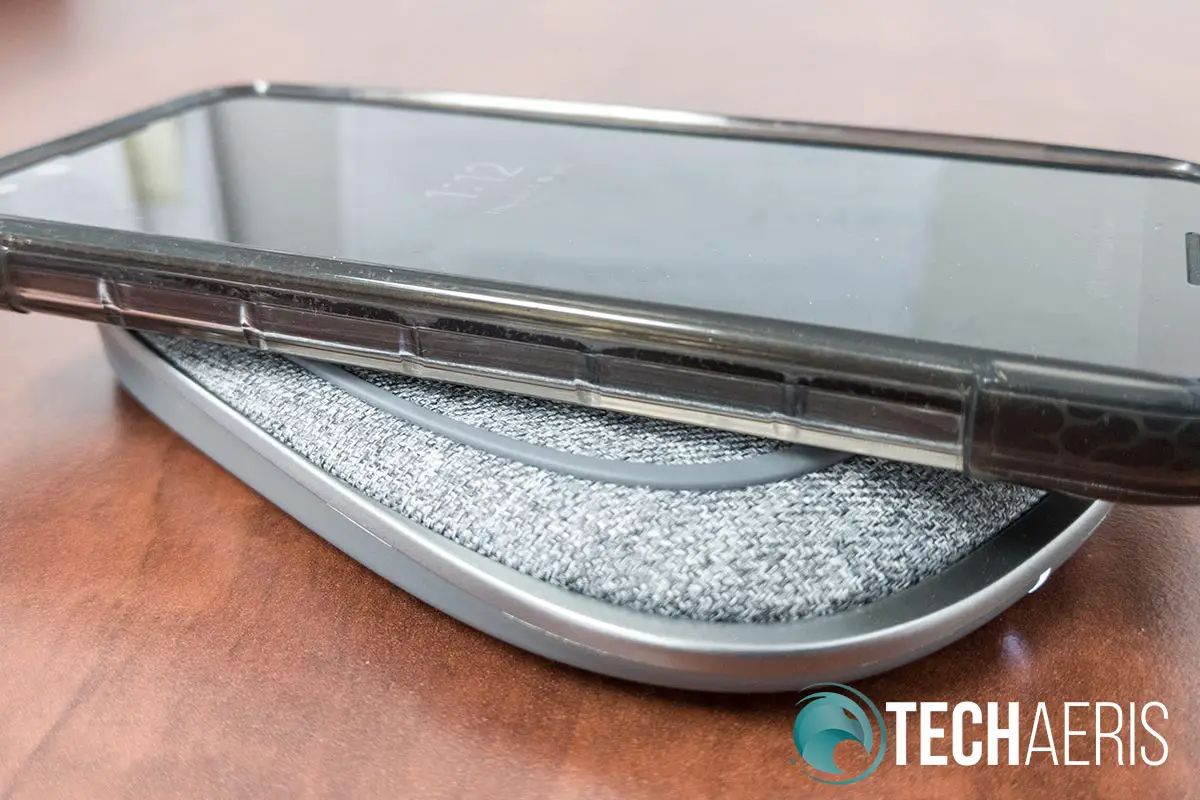
I did have a chance to briefly test out a Samsung device and it did seem to charge faster on the Otto Q than the Pixel 3 did which would indicate it does indeed support the faster wireless charging speeds.
Both devices also have Foreign Object Detection technology. When a metal object is detected on the top, the wireless charging will shut off to prevent heating the metal piece and, by proxy, your phone.
Battery Life
While battery life is a moot point on the Otto Q, the Porto Q doubles as a portable power bank. In addition to being able to wireless charge your device on the go, you can also plug it — or a non-wireless charging enabled device — into the Porto Q to charge it up. In fact, you can charge two devices at once — one wirelessly and the other wired.
The Porto Q isn’t the biggest power bank out there, however, and only sports a 5,000 mAh battery. With most smartphones sitting around the 3,000 mAh battery size, this power bank will likely get you just under two full charges. While it’s not the greatest capacity out there, it’ll definitely do the trick to get you a little extra battery while out and about if you
Price/Value
The Moshi Otto Q has an MSRP of US$39.95, while the Porto Q retails for $84.95. Sure, they both have quite a bit more style design-wise than other charging pads and wireless charging banks on the market, but they’re also some of the more expensive. In both cases, you’re definitely paying a premium for the design.
Moshi Otto Q photo gallery
Moshi Porto Q 5K photo gallery
Wrap-up
There’s no question there are more affordable wireless charging pad options out there. That being said, if you’re after a bit of style, the Moshi Q Wireless Charging Collection looks great sitting on your desk, with or without your phone charging on top.
*We were sent a sample of the Moshi Otto Q and Porto Q 5K for the purposes of this review.
Moshi Porto Q 5K
US$84.95Last Updated on February 3, 2021.

